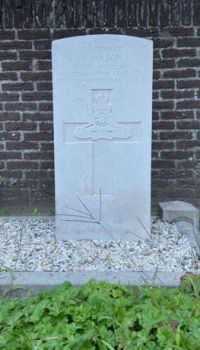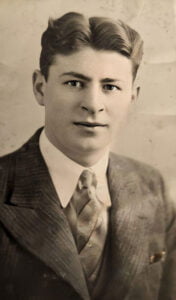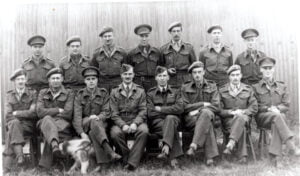Wilson | John
- First names
John
- Age
26
- Date of birth
12-11-1918
- Date of death
15-11-1944
- Service number
149792
- Rank
Lieutenant
- Regiment
Royal Artillery
- Grave number
Sint Anthonis Grave 2


Author John Burn
Biography
John was born on 12 November 1918 the son of John and Mary Wilson of 2 Murdieston Street Greenock. The eldest of six siblings Mary, known as May (1920), served in the ATS in WW2, Archibald, known as Archie (1923) served in merchant navy during WW2, Isabella (1925) served in the WAAF in WW2, Flora (1927) and David (1931).
John attended Greenock High School gaining his Higher National Leaving Certificate. As the eldest of six children John saw it as his duty to leave school rather than go to university, where it was thought he might study law. His father was ill with multiple sclerosis and in August 1935 John started to work at the Royal Navy Torpedo Factory, Greenock as an apprentice mechanical engineer. His training included engine fitting and assembly, millwright work, jig and gauge fitting and turning, eventually gaining his National Certificate of Mechanical Engineering after studying at the Watt Technical College in Greenock.
As keen athlete, he was persuaded to enlist as a Territorial in No2 Company, The Renfrewshire Fortress, Royal Engineers based in Greenock to join its athletics team and did so on 10 February 1938. On 12 May 1938 he obtained his Certificate of Trade Proficiency as a Pioneer Fitter EIII.
On 10 June 1938 his father died.
During his time with the Territorials John continued to work at the Torpedo Factory and eventually moved to working in the Drawing Office. He completed the Territorial Camp from 27 September to 7 October 1938, he also attended camp in 1939 but no dates are given in his record. On 24 August 1939 John was called out on Military Service under Section 13(2)(b) of the Reserve Forces Act 1907 and on the same date re mustered as an Engine Artificer Group A Class III. On 2 May 1940 John was posted to 123rd OCTU at Catterick and on 2 September 1940 granted an emergency commission in the Royal Artillery. He joined 304 (City of Dundee) Battery 127 (Highland) Field Regiment RA as a Gun Position Officer. John continued with his athletics and in 1941 he was the Highland Division 1 mile winner at the Highland Games.

On 16 June 1942 the unit left the UK, some ships sailed from Greenock, and sailed for North Africa by way of South Africa, leaving Durban on 16 July and disembarked on 14th August 1942 at the entrance to the Suez Canal at Port Tewfik.
In late August the Division moved into the Nile delta through Khatatba. Here they took up positions to defend the western approaches to Cairo. At this time the enemy were no more than 50 miles west in the area of El Alamein and to its south. Montgomery launched his attack at Alamein on 30 August. After El Alamein the unit was also involved in action at Medenine, Mareth and Wadi Akarit.
Casualty records show that John was wounded on 22 March 1943 but the extent of the wound is not recorded.
The unit left Egypt for Algeria on 15 May 1943 and John enjoyed a period of R&R in the port of Bougie in Algeria.
On 3 September 1943 of Sicily John’s unit was involved in the invasion of Sicily.
He returned to UK on 28 November 1943 when the division was to prepare for the invasion of Europe..


He joined no 35 AOP course on 3 May 1944 initially completing Elementary Flying Training School and subsequently the Operational Training Unit (OTU) on 20 July 1944.
After training John was posted 659 Sqn RAF and flew out of the UK on 2 November.
John sent a letter to his sister, May, on 6 November 1944:
“I’m billeted in a Dutch farmhouse two rooms of which we requisitioned tonight. There are about nineteen children, and although I have always been able to compete with French and Italian, Dutch just leaves me speechless. The old farmer and his wife have just come and given us a glass of milk. We said all sorts of nice things to each other which neither party understood at all but we both smiled happily and there the matter rests.”
On 15 November John was having continuation training when his Auster stalled and crashed, killing him.
The medals he was posthumously awarded were:
- 1939-45 Star
- Africa Star
- Italy Star
- France & Germany Star
- Defence Medal
- War Medal 1939-45
These medals were sent to his mother.

The Greenock and District Territorial Army, who at the time were the Scottish Army cross country champions, every-one of them a member of Greenock Glenpark Harriers. That same team also went on to represent Scotland and win the UK British Army Championship title three years in a row. This photo was actually taken circa 1938/39. John is shown in the photograph seated fourth from the left next to the sergeant. It is likely John was a member of the team in 1938 & 39.
Letter to his mother
Major CDV Prendergast RA
659 Sqn RAF
BLA
Jan 6th
Dear Mrs Wilson
I cannot tell you how sad we all feel about your son’s accident. I expect you have already been told by his friends how it happened but I thought I would write to tell you how very much we miss his cheerful presence and how keenly we feel his absence now.
He’d only been with us for such a short time and we were all just getting to know him and from the little contact I had with him I couldn’t have wished for any-one more keen on his work and likely to have done well. It was therefore a great shock to us for this dreadful accident to happen so soon after his arrival just as he was settling down.
The only comfort, small though it may be, is that he must have been killed instantly and suffered no pain. He lies now in a quiet churchyard in a little village called Sint Anthonis some ten miles east of Helmond in as pleasant surroundings as can be found in this part of the world.
Please accept the deepest sympathy of myself and all my officers in your great loss.
Yours sincerely
Evelyn Prendergast.
Letters regarding his crash
Additional documents
Sources and credits
Photo of John Findagrave website
Text, photo’s and documents made available by his nephew John Burn, Isabella’s son.
Page from the book: Vliegtuigcrashes en Noodlandingen WOII gemeente Sint Anthonis; Ruud Wildekamp (Red.) en werkgroep. (Aircraft Crashes and Emergency Landings WWII Municipality of Sint Anthonis; Ruud Wildekamp (Ed.) and working group.)
Research Anny Huberts







